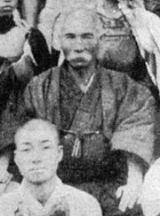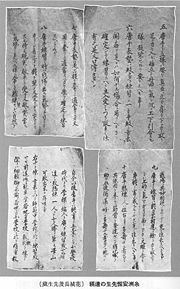
Anko Itosu
Encyclopedia
is considered by many the father of modern karate
, although this title is also often given to Gichin Funakoshi
because the latter spread karate throughout Japan.
. Itosu began his tode (karate) study under Nagahama Chikudun Pechin. His study of the art led him to Sokon Matsumura
. Part of Itosu's training was makiwara
practice. He once tied a leather sandal to a stone wall in an effort to build a better makiwara. After several strikes, the stone fell from the wall. After relocating the sandal several times, Itosu had destroyed the wall.
Itosu served as a secretary to the last king of the Ryukyu Islands
until Japan abolished the Okinawa-based native monarchy in 1879. In 1901, he was instrumental in getting karate introduced into Okinawa's schools. In 1905, Itosu was a part-time teacher of To-te at Okinawa's First Junior Prefectural High School. It was here that he developed the systematic method of teaching karate techniques that are still in practice today. He created and introduced the Pinan forms (Heian in Japanese) as learning steps for students, because he felt the older forms (kata in Japanese) were too difficult for schoolchildren to learn. The five Pinan forms were created by drawing from two older forms: kusanku and chiang nan
. Itosu is also credited with taking the large Naihanchi form (tekki in Japan) and breaking it into the three well-known modern forms Naihanchi Shodan, Naihanchi Nidan, and Naihanchi Sandan. In 1908, Itosu wrote the influential "Ten Precepts (Tode Jukun) of Karate," reaching beyond Okinawa to Japan. Itosu's style of karate, Shorin-ryu
, came to be known as Itosu-ryu in recognition of his skill, mastery, and role as teacher to many.
While Itosu did not invent karate himself, he modified the kata (forms) he learned from his master, Matsumura, and taught many karate masters. Itosu's students included Choyu Motobu (1857–1927), Choki Motobu (1870–1944), Kentsu Yabu
(1866–1937), Chomo Hanashiro (1869–1945), Gichin Funakoshi (1868–1957), Moden Yabiku (1880–1941), Kanken Toyama
(1888–1966), Chotoku Kyan (1870–1945), Shinpan Shiroma (Gusukuma)
(1890–1954), Anbun Tokuda (1886–1945), Kenwa Mabuni
(1887–1952), and Chōshin Chibana
(1885–1969).

This letter was influential in the spread of karate.
Karate
is a martial art developed in the Ryukyu Islands in what is now Okinawa, Japan. It was developed from indigenous fighting methods called and Chinese kenpō. Karate is a striking art using punching, kicking, knee and elbow strikes, and open-handed techniques such as knife-hands. Grappling, locks,...
, although this title is also often given to Gichin Funakoshi
Gichin Funakoshi
was the creator of Shotokan karate, perhaps the most widely known style of karate, and is attributed as being the 'father of modern karate.' Following the teachings of Anko Itosu, he was one of the Okinawan karate masters who introduced karate to the Japanese mainland in 1921...
because the latter spread karate throughout Japan.
Biography
Itosu was born in 1831 and died in 1915. Ethnically Okinawan, Itosu was small in stature, shy, and introverted as a child. He was raised in a strict home of the keimochi (a family of position), and was educated in the Chinese classics and calligraphyCalligraphy
Calligraphy is a type of visual art. It is often called the art of fancy lettering . A contemporary definition of calligraphic practice is "the art of giving form to signs in an expressive, harmonious and skillful manner"...
. Itosu began his tode (karate) study under Nagahama Chikudun Pechin. His study of the art led him to Sokon Matsumura
Sokon Matsumura
was one of the original karate masters of Okinawa. His life is reported variously as or or or -Early history:...
. Part of Itosu's training was makiwara
Makiwara
The makiwara is a padded striking post used as a training tool in various styles of traditional karate. It is thought to be uniquely Okinawan in origin...
practice. He once tied a leather sandal to a stone wall in an effort to build a better makiwara. After several strikes, the stone fell from the wall. After relocating the sandal several times, Itosu had destroyed the wall.
Itosu served as a secretary to the last king of the Ryukyu Islands
Ryukyu Islands
The , also known as the , is a chain of islands in the western Pacific, on the eastern limit of the East China Sea and to the southwest of the island of Kyushu in Japan. From about 1829 until the mid 20th century, they were alternately called Luchu, Loochoo, or Lewchew, akin to the Mandarin...
until Japan abolished the Okinawa-based native monarchy in 1879. In 1901, he was instrumental in getting karate introduced into Okinawa's schools. In 1905, Itosu was a part-time teacher of To-te at Okinawa's First Junior Prefectural High School. It was here that he developed the systematic method of teaching karate techniques that are still in practice today. He created and introduced the Pinan forms (Heian in Japanese) as learning steps for students, because he felt the older forms (kata in Japanese) were too difficult for schoolchildren to learn. The five Pinan forms were created by drawing from two older forms: kusanku and chiang nan
Chiang Nan
Henry Liu , often known by his pen name Chiang Nan , was a writer and journalist from Taiwan, Republic of China...
. Itosu is also credited with taking the large Naihanchi form (tekki in Japan) and breaking it into the three well-known modern forms Naihanchi Shodan, Naihanchi Nidan, and Naihanchi Sandan. In 1908, Itosu wrote the influential "Ten Precepts (Tode Jukun) of Karate," reaching beyond Okinawa to Japan. Itosu's style of karate, Shorin-ryu
Shorin-Ryu
is one of the major modern Okinawan martial arts. It was founded by Choshin Chibana in 1933. Shōrin-ryū combines elements of the traditional Okinawan fighting styles of Shuri-te.-History:Chosin Chibana was a top student of the great master of shuri-te, Anko Itosu...
, came to be known as Itosu-ryu in recognition of his skill, mastery, and role as teacher to many.
While Itosu did not invent karate himself, he modified the kata (forms) he learned from his master, Matsumura, and taught many karate masters. Itosu's students included Choyu Motobu (1857–1927), Choki Motobu (1870–1944), Kentsu Yabu
Kentsu Yabu
was a prominent teacher of Shōrin-ryū karate in Okinawa from the 1910s until the 1930s, and was among the first people to demonstrate karate in Hawaii.- History :...
(1866–1937), Chomo Hanashiro (1869–1945), Gichin Funakoshi (1868–1957), Moden Yabiku (1880–1941), Kanken Toyama
Kanken Toyama
Kanken Tōyama was a Japanese schoolteacher and karate master, who developed the foundation for the Shūdōkan karate style....
(1888–1966), Chotoku Kyan (1870–1945), Shinpan Shiroma (Gusukuma)
Shinpan Gusukuma
, also known as Shinpan Shiroma by the Japanese, was an Okinawan martial artist who studied Shōrin-ryū karate as a student of Ankō Itosu. Gusukuma also trained under Higaonna Kanryō in the Naha-te style. Gusukuma went on to establish Shitō-ryū with Kenwa Mabuni....
(1890–1954), Anbun Tokuda (1886–1945), Kenwa Mabuni
Kenwa Mabuni
was one of the first karateka to teach karate on mainland Japan and is creditied as developing the style known as Shitō-ryū .-Achievements:# Funakoshi Gichin learned kata from Kenwa Mabuni: In order to expand his knowledge he sent his son Gigō to study kata in Mabuni's dōjō in Osaka.# Kenwa Mabuni,...
(1887–1952), and Chōshin Chibana
Choshin Chibana
was an Okinawan martial artist who developed Shorin-ryū karate based on what he had learned from Ankō Itosu.Chibana was the last of the pre-World War karate masters, also called the "Last Warrior of Shuri" He was the first to establish a Japanese ryu name for an Okinawan karate style, calling...
(1885–1969).
Ten Precepts (Tode Jukun) of Karate
In October 1908, Itosu wrote a letter, "Ten Precepts (Tode Jukun) of Karate," to draw the attention of the Ministry of Education and the Ministry of War in Japan. A translation of that letter reads:
- Ten Precepts of Karate
- Karate did not develop from BuddhismBuddhismBuddhism is a religion and philosophy encompassing a variety of traditions, beliefs and practices, largely based on teachings attributed to Siddhartha Gautama, commonly known as the Buddha . The Buddha lived and taught in the northeastern Indian subcontinent some time between the 6th and 4th...
or ConfucianismConfucianismConfucianism is a Chinese ethical and philosophical system developed from the teachings of the Chinese philosopher Confucius . Confucianism originated as an "ethical-sociopolitical teaching" during the Spring and Autumn Period, but later developed metaphysical and cosmological elements in the Han...
. In the past the Shorin-ryu school and the Shorei-ryu school were brought to Okinawa from China. Both of these schools have strong points, which I will now mention before there are too many changes:- Karate is not merely practiced for your own benefit; it can be used to protect one's family or master. It is not intended to be used against a single assailant but instead as a way of avoiding a fight should one be confronted by a villain or ruffian.
- The purpose of karate is to make the muscles and bones hard as rock and to use the hands and legs as spears. If children were to begin training in Tang Te while in elementary school, then they will be well suited for military service. Remember the words attributed to the Duke of WellingtonArthur Wellesley, 1st Duke of WellingtonField Marshal Arthur Wellesley, 1st Duke of Wellington, KG, GCB, GCH, PC, FRS , was an Irish-born British soldier and statesman, and one of the leading military and political figures of the 19th century...
after he defeated Napoleon: "The Battle of Waterloo was won on the playing fields of Eton." - Karate cannot be quickly learned. Like a slow moving bull, it eventually travels a thousand miles. If one trains diligently every day, then in three or four years one will come to understand karate. Those who train in this fashion will discover karate.
- In karate, training of the hands and feet are important, so one must be thoroughly trained on the makiwara. In order to do this, drop your shoulders, open your lungs, take hold of your strength, grip the floor with your feet, and sink your energy into your lower abdomen. Practice using each arm one to two hundred times each day.
- When one practices the stances of Tang Te, be sure to keep your back straight, lower your shoulders, put strength in your legs, stand firmly, and drop your energy into your lower abdomen.
- Practice each of the techniques of karate repeatedly, the use of which is passed by word of mouth. Learn the explanations well, and decide when and in what manner to apply them when needed. Enter, counter, release is the rule of releasing hand (torite).
- You must decide if karate is for your health or to aid your duty.
- When you train, do so as if on the battlefield. Your eyes should glare, shoulders drop, and body harden. You should always train with intensity and spirit, and in this way you will naturally be ready.
- One must not overtrain; this will cause you to lose the energy in your lower abdomen and will be harmful to your body. Your face and eyes will turn red. Train wisely.
- In the past, masters of karate have enjoyed long lives. Karate aids in developing the bones and muscles. It helps the digestion as well as the circulation. If karate should be introduced beginning in the elementary schools, then we will produce many men each capable of defeating ten assailants. I further believe this can be done by having all students at the Okinawa Teachers' College practice karate. In this way, after graduation, they can teach at the elementary schools at which they have been taught. I believe this will be a great benefit to our nation and our military. It is my hope you will seriously consider my suggestion.
- Anko Itosu, October 1908
This letter was influential in the spread of karate.

